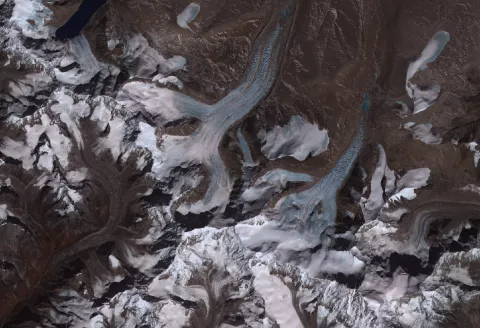The National Snow and Ice Data Center (NSIDC) is part of the Cooperative Institute for Research in Environmental Sciences at the University of Colorado Boulder.
A new book from the international GLIMS (Global Land Ice Measurements from Space) initiative, an international collaboration including the National Snow and Ice Data Center at the University of Colorado Boulder, provides the most comprehensive report to date on global glacier changes.
The book, Global Land Ice Measurements from Space, presents an overview and detailed assessment of changes in the world’s glaciers by using satellite imagery from optical satellite instruments such as ASTER (Advanced Spaceborne Thermal Emission and Reflection Radiometer) and Landsat.
While the shrinking of glaciers on all continents is already known from ground observations of individual glaciers, by using repeated satellite observations GLIMS has firmly established that glaciers are shrinking globally. Although some glaciers are maintaining their size, most glaciers are dwindling. The foremost cause of the worldwide reductions in glaciers is global warming, the team writes.
The full-color book has twenty-five regional chapters that illustrate glacier changes from the Arctic to the Antarctic. Other chapters provide a thorough theoretical background on glacier monitoring and mapping, remote sensing techniques, uncertainties, and interpretation of the observations in a climatic context. The book highlights many other glacier research applications of satellite data, including measurement of glacier thinning from repeated satellite-based digital elevation models (DEMs) and calculation of surface flow velocities from repeated satellite images.
These tools are key to understanding local and regional variations in glacier behavior, the team writes. The high sensitivity of glaciers to climate change has substantially decreased their volume and changed the landscape over the past decades, affecting both regional water availability and the hazard potential of glaciers. The growing GLIMS database about glaciers also contributed to the Intergovernmental Panel on Climate Change (IPCC) Fifth Assessment Report issued in 2013. The IPCC report concluded that most of the world’s glaciers have been losing ice at an increasing rate in recent decades.
More than 60 institutions across the globe are involved in GLIMS, with more than 150 scientists from all over the world contributing to this compilation. Jeffrey S. Kargel of the Department of Hydrology and Water Resources at the University of Arizona coordinates the project. The GLIMS glacier database and GLIMS web site are developed and maintained by the National Snow and Ice Data Center (NSIDC) at the University of Colorado in Boulder.
Related information:
GLIMS book: http://www.springer.com/us/book/9783540798170
GLIMS Web site: http://glims.org
GLIMS Glacier Database: http://glims.colorado.edu/glacierdata/
Contact information:
Bruce Raup, National Snow and Ice Data Center, braup@nsidc.org, +1 303-492-8814
Jeffrey S. Kargel, University of Arizona, Kargel@hwr.arizona.edu, +1 520-780-7759
Media:
Jane Beitler
jbeitler@nsidc.org
+1 303-492-1160
